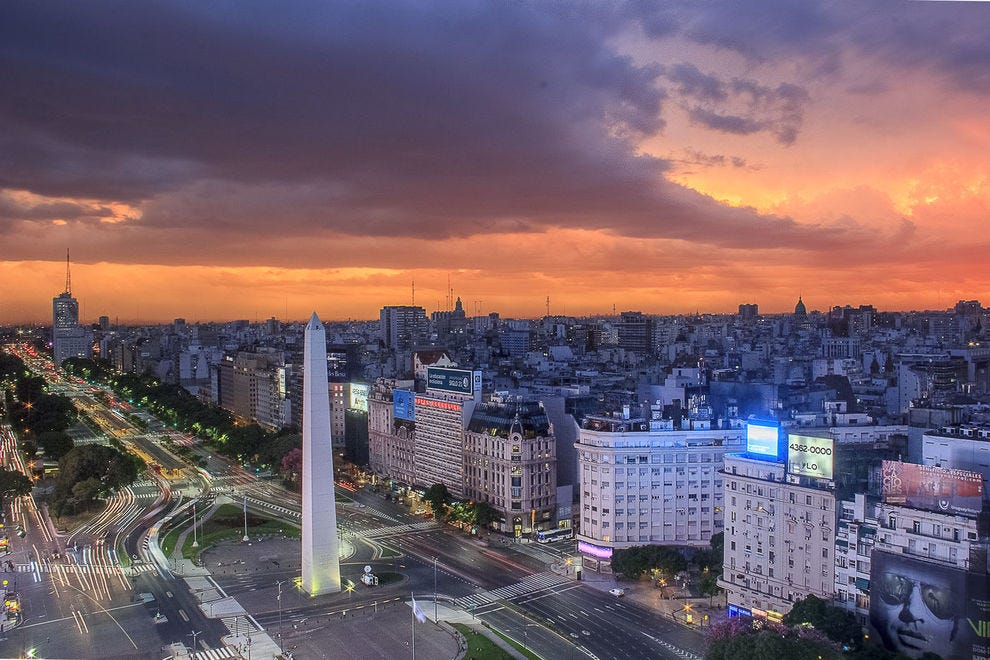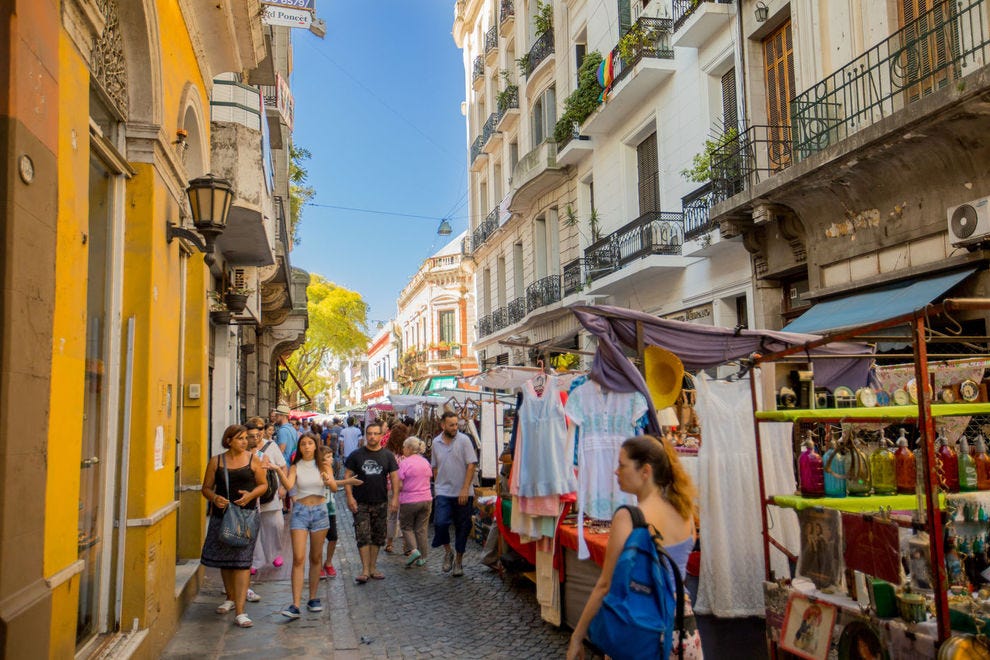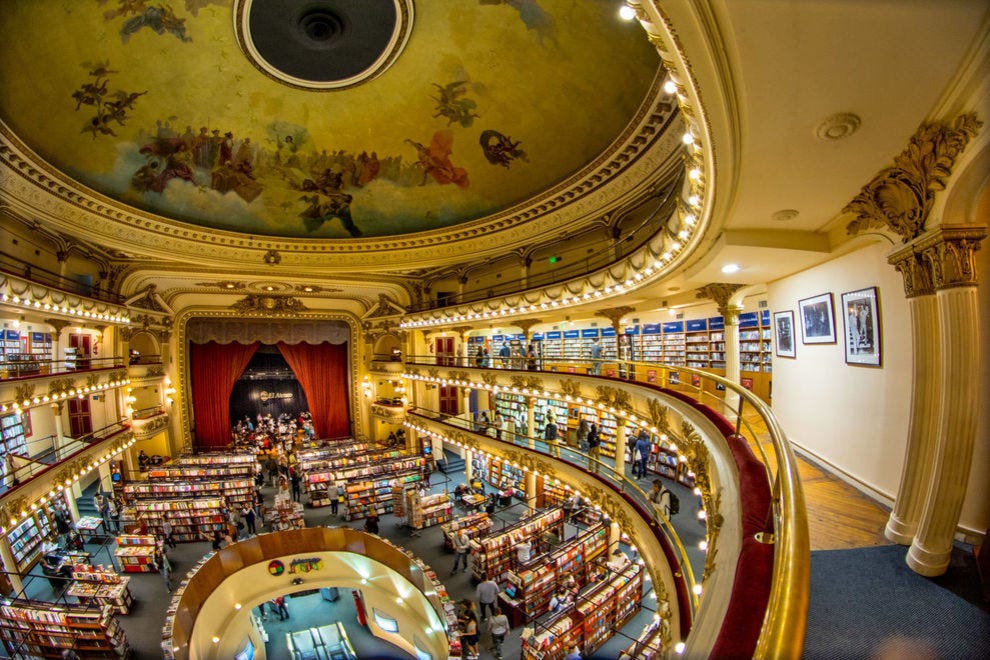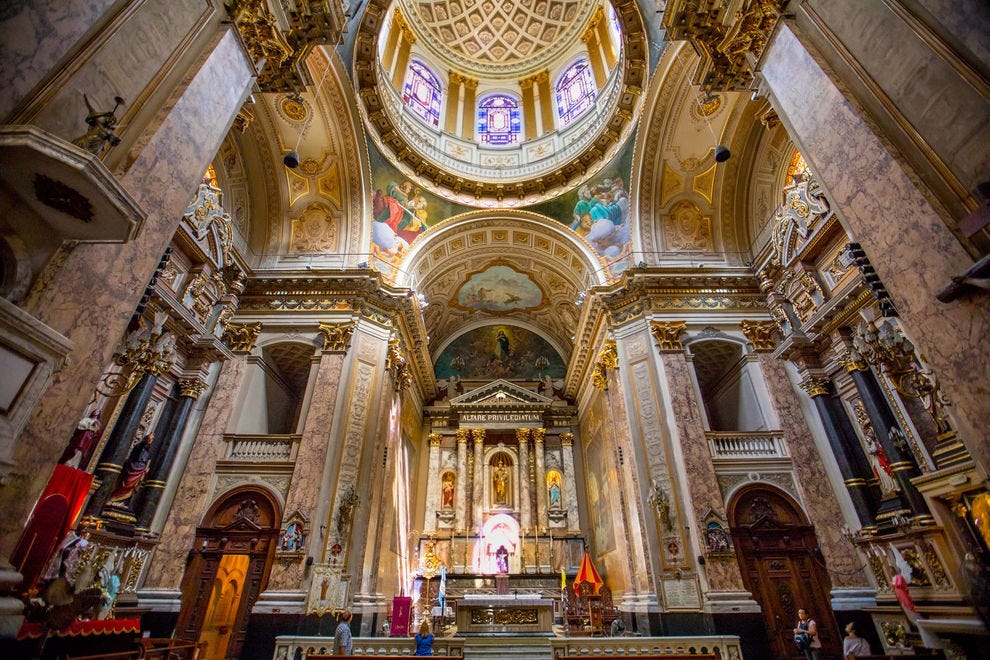 Photo courtesy of @travelbuenosaires
Photo courtesy of @travelbuenosaires
Welcome to Buenos Aires
European splendor meets Latin flair in the city of Buenos Aires. The Argentine capital is known for its magnificent architecture, colorful barrios and the sultry dance known as the tango. Come along for a tour of this South American city through 20 photos.
 Photo courtesy of @travelbuenosaires
Photo courtesy of @travelbuenosaires
Heart of the city
Buenos Aires’s oldest public square, Plaza de Mayo, gets its name from the Argentine Revolution that kicked off on May 25, 1810. The Metropolitan Cathedral and Casa Rosada (the seat of the national government) flank the square, which has become a popular site for public gatherings and protests.
 Photo courtesy of iStock / simonmayer
Photo courtesy of iStock / simonmayer
The pink house
Eva Perón, one of Argentina’s most famous figures, addressed the masses from the balcony of the Casa Rosada (Pink House) in Plaza de Mayo during her time as the First Lady of Argentina in the 1940s and 1950s. The stately structure still serves as the presidential palace.
 Photo courtesy of @travelbuenosaires
Photo courtesy of @travelbuenosaires
Colorful Caminito
Each neighborhood in Buenos Aires has its own unique personality, but none is quite as colorful as La Boca, a working class barrio. Take a stroll along Caminito to see the painted wood and sheet metal tenement buildings typical of those built by immigrants during the late 19th century.
 Photo courtesy of @travelbuenosaires
Photo courtesy of @travelbuenosaires
A bite to eat
If you get hungry while visiting La Boca, stop in for a bite to eat at Restaurante El Obrero. This local institution, known for its Argentine steaks and Italian food, has been serving patrons since 1954 and is frequented by locals and visiting international celebrities alike.
 Photo courtesy of @travelbuenosaires
Photo courtesy of @travelbuenosaires
Cross-town rivalry
Porteños take their soccer seriously, and if you live in the city, chances are you’re either a fan of the Boca Juniors (fans pictured) or their rivals River Plate. The former is considered the club of Argentina’s working class, while River Plate goes by the nickname ‘los millonarios’ (the millionaires) for its wealthier supporters.
 Photo courtesy of @travelbuenosaires
Photo courtesy of @travelbuenosaires
Sundays in San Telmo
Cobbled streets and faded, grand architecture combine to make San Telmo one of the city’s more atmospheric barrios. Come on Sundays, when Plaza Dorrego and the surrounding streets host a lively antiques fair, complete with street performers and professional tango dancers showing off in the square.
 Photo courtesy of @travelbuenosaires
Photo courtesy of @travelbuenosaires
City of the dead
Recoleta Cemetery, one of the city’s most visited attractions, feels like its own little city, complete with streets lined with crypts and coffins, and green spaces dotted with statuary. The eerily beautiful site serves as the final resting place for numerous luminaries, including Eva “Evita” Perón.
 Photo courtesy of @travelbuenosaires
Photo courtesy of @travelbuenosaires
Birthplace of tango
The sensual tango was born on the streets of Buenos Aires more than a century ago, when largely male dockworkers would gather after hours to drink and show off their fancy footwork. Grand theaters around town host dance shows, while local dance halls, called ‘milongas,’ offer an unstaged experience.
 Photo courtesy of @travelbuenosaires
Photo courtesy of @travelbuenosaires
A walk in the park
Parque Lezama, once the private garden of the Lezama family, is now one of the city’s oldest public parks. The leafy green space makes for excellent people watching, as you’ll often see older gentlemen playing chess, groups of friends sharing a mate (tea served in a gourd) and kids playing in the grass.
 Photo courtesy of @travelbuenosaires
Photo courtesy of @travelbuenosaires
World’s most beautiful bookstore?
Bookworms will find one of the world’s most visually stunning bookstores inside a former theater in Buenos Aires. El Ateneo Grand Splendid lives up to its name, with a beautifully preserved dome and frescoes by Italian painter Nazareno Orlandi. The stage area now serves as a cafe.
 Photo courtesy of @travelbuenosaires
Photo courtesy of @travelbuenosaires
Palermo Woods
Parque Tres de Febrero (also known as the Palermo Woods), the city’s biggest and most popular park, features a lake, poets garden and a rose garden with some 8,000 rose bushes representing 93 species. Give your feet a rest by taking a seat in the Patio Andaluz, a patio in the corner of the garden with a fountain and painted tiles from Spain.
 Photo courtesy of @travelbuenosaires
Photo courtesy of @travelbuenosaires
The church of the Pope
When Pope Francis was a child, he regularly attended mass at the Basílica de San José de Flores. This grand basilica, inaugurated in 1883, is one of many beautiful examples of Catholic architecture in the city.
Others worth a visit include the Basílica del Santísimo Sacramento, Iglesia de San Miguel de Arcángel, Basílica Santa Rosa de Lima and the Metropolitan Cathedral.
 Photo courtesy of @travelbuenosaires
Photo courtesy of @travelbuenosaires
Café culture
During the late 1800s and early 1900s, a massive wave of Italian and French immigrants made their way to Argentina, bringing with them a strong café culture. For many Porteños (residents of the city), sipping a café con leche with a medialuna (croissant) is a daily ritual.
Café Tortoni is perhaps the most famous spot in the city, but you’ll find a cafe on just about every corner.
 Photo courtesy of @travelbuenosaires
Photo courtesy of @travelbuenosaires
An architectural gem
Keep an eye out, and you’ll find little architectural gems all over the city of Buenos Aires. La Estrella Pharmacy, for example, was built in 1895 and still features its original furnishings and decor. The city bought the property in 1970, but it continues to operate as a working pharmacy.
Photo courtesy of iStock / Natalia SO
A bit of Spain in Argentina
Spanish architect Santiago Calatrava designed the Puente de la Mujer (Woman’s Bridge), taking inspiration from the tango. Since its installation in 2001, the bridge has become a symbol of Puerto Madero, one of the city’s newest, sleekest neighborhoods.
 Photo courtesy of @travelbuenosaires
Photo courtesy of @travelbuenosaires
World’s longest mural
Alfredo Segatori painted this mural, known as “El Regreso de Quinquela” (“The Return of Quinquela”) as a tribute to local painter Benito Quinquela Martín (1890-1977). The work of art is the longest mural in the world painted by a single artist. It’s one of hundreds of murals adorning the walls of the city.
 Photo courtesy of @travelbuenosaires
Photo courtesy of @travelbuenosaires
A passion for polo
British immigrants who came to Argentina in the 19th century brought with them the sport of polo. Today, Buenos Aires ranks among the world’s best places to watch the sport. The historic polo ground in Palermo, known as the Cathedral of Polo, hosts the Triple Crown each year.
 Photo courtesy of @travelbuenosaires
Photo courtesy of @travelbuenosaires
Gaucho culture
Get a taste for Argentina’s more rural side with a visit to the Feria de Mataderos. This weekly craft fair in the Mataderos neighborhood celebrates the country’s gaucho (cowboy) culture with craft items, live performances, horse riding competitions and regional cuisine.
 Photo courtesy of iStock / diegograndi
Photo courtesy of iStock / diegograndi
Riverside getaway
Hop aboard a train for the short ride to Tigre, a popular riverside getaway from the city center. This town on the banks of the Tigre River is known for its network of islands and canals, stilt houses and craft shops. Do some shopping at the Puerto de Frutos market or rent a kayak to explore the river delta from the water.
